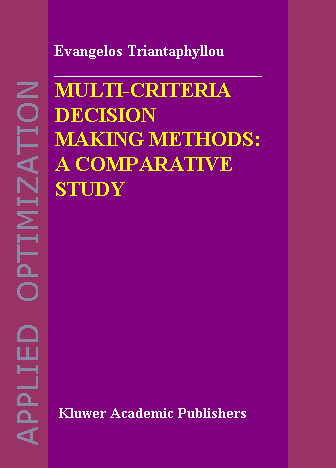
|
Multi-Criteria Decision Making Methods:
A Comparative Study by Evangelos Triantaphyllou, Ph.D. A monograph published on November 2000 (and a reprint in June of 2002) by  Kluwer Academic Publishers
Kluwer Academic Publishers
Applied Optimization Series, Vol. 44 ISBN 0-7923-6607-7 |

TABLE OF CONTENTS
List of Figures................................................xiii List of Tables..................................................xix Foreword......................................................xxiii Preface.........................................................xxv Acknowledgments.................................................xxix 1 Introduction to Multi-Criteria Decision Making............1 1.1 Multi-Criteria Decision Making: A General Overview................................1 1.2 Classification of MCDM Methods....................32 Multi-Criteria Decision Making Methods....................5 2.1 Background Information............................5 2.2 Description of Some MCDM Methods..................5 2.2.1 The WSM Method............................6 2.2.2 The WPM Method............................8 2.2.3 The AHP Method............................9 2.2.4 The Revised AHP Method...................11 2.2.5 The ELECTRE Method.......................13 2.2.6 The TOPSIS Method........................18
3 Quantification of Qualitative Data for MCDM Problems............................................23 3.1 Background Information...........................23 3.2 Scales for Quantifying Pairwise Comparisons......25 3.2.1 Scales Defined on the Interval [9, 1/9]..26 3.2.2 Exponential Scales.......................28 3.2.3 Some Examples of the Use of Exponential Scales.......................29 3.3 Evaluating Different Scales......................32 3.3.1 The Concepts of the RCP and CDP Matrices.................................32 3.3.2 On The Consistency of CDP Matrices.......35 3.3.3 Two Evaluative Criteria..................43 3.4 A Simulation Evaluation of Different Scales......44 3.5 Analysis of the Computational Results............50 3.6 Conclusions......................................53
4 Deriving Relative Weights from Ratio Comparisons............57 4.1 Background Information...............................57 4.2 The Eigenvalue Approach..............................58 4.3 Some Optimization Approaches.........................60 4.4 Considering The Human Rationality Factor.............61 4.5 First Extensive Numerical Example....................65 4.6 Second Extensive Numerical Example...................66 4.7 Average Error per Comparison for Sets of Different Size....................................67 4.8 Conclusions..........................................72
5 Deriving Relative Weights from Difference Comparisons.......73 5.1 Background Information...............................73 5.2 Pairwise Comparisons of Relative Similarity..........76 5.2.1 Quantifying Pairwise Comparisons of Relative Similarity.......................76 5.2.2 Processing Pairwise Comparisons of Relative Similarity.......................77 5.2.3 An Extensive Numerical Example...............79 5.3 Conclusions..........................................85
6 A Decomposition Approach for Evaluating Relative Weights Derived from Comparisons............................87 6.1 Background Information...............................87 6.2 Problem Description..................................88 6.3 Two Solution Approaches..............................91 6.3.1 A Simple Approach............................91 6.3.2 A Linear Programming Approach................92 6.4 An Extensive Numerical Example.......................95 6.5 Some Computational Experiments.......................97 6.6 Analysis of the Computational Results...............100 6.7 Conclusions.........................................112
7 Reduction of Pairwise Comparisons Via a Duality Approach...........................................115 7.1 Background Information..............................115 7.2 A Duality Approach for Eliciting Comparisons........116 7.3 An Extensive Numerical Example......................120 7.3.1 Applying the Primal Approach................121 7.3.2 Applying the Dual Approach..................122 7.4 Some Numerical Results for Problems of Different Sizes.....................................124 7.5 Conclusions.........................................128
8 A Sensitivity Analysis Approach for MCDM Methods...........131 8.1 Background Information..............................131 8.2 Description of the Two Major Sensitivity Analysis Problems...................................133 8.3. Problem 1: Determining the Most Critical Criterion..................................135 8.3.1 Definitions and Terminology.................135 8.3.2 Some Theoretical Results in Determining the Most Critical Criterion.................137 8.3.2.1 Case (i): Using the WSM or the AHP Method..................137 8.3.2.2 An Extensive Numerical Example for the WSM Case...................138 8.3.2.3 Case (ii): Using the WPM Method.............................142 8.3.2.4 An Extensive Numerical Example for the WPM Case...................143 8.3.3 Some Computational Experiments..............145 8.4 Problem 2: Determining the Most Critical aij Measure of Performance..............................155 8.4.1 Definitions and Terminology.................155 8.4.2 Determining the Threshold Values d/i,j,k.....157 8.4.2.1 Case (i): When Using the WSM or the AHP Method..................157 8.4.2.2 An Extensive Numerical Example When the WSM or the AHP Method is Used.................158 8.4.2.3 Case (ii): When Using the WPM Method.............................161 8.4.2.4 An Extensive Numerical Example When the WPM Method is Used........161 8.5 Conclusions.........................................165 Appendix to Chapter 8......................................167 8.6 Calculation of the t1,1,2 Quantity When the AHP or the WSM Method is Used...................167 8.7 Calculation of the t1,1,2 Quantity When the WPM Method is Used..............................169 8.8 Calculation of the d3,4,5 Quantity When the WSM Method is Used..............................170 8.9 Calculation of the d3,4,5 Quantity When the AHP Method is Used..............................171 8.10 Calculation of the d3,4,5 Quantity When the WPM Method is Used..............................174
9 Evaluation of Methods for Processing a Decision Matrix and Some Cases of Ranking Abnormalities....................177 9.1 Background Information..............................177 9.2 Two Evaluative Criteria.............................177 9.3 Testing the Methods by Using the First Evaluative Criterion................................179 9.4 Testing the Methods by Using the Second Evaluative Criterion................................186 9.5 Analysis of the Computational Results...............192 9.6 Evaluating the TOPSIS Method........................194 9.7 Conclusions.........................................197
10 A Computational Evaluation of the Original and the Revised AHP................................................201 10.1 Background Information...............................201 10.2 An Extensive Numerical Example.......................202 10.3 Some Computational Experiments.......................206 10.4 Conclusions..........................................212
11 More Cases of Ranking Abnormalities When Some MCDM Methods Are Used......................................213 11.1 Background Information...............................213 11.2 Ranking Irregularities When Alternatives Are Compared Two at a Time...............................215 11.3 Ranking Irregularities When Alternatives Are Compared Two at a Time and Also as a Group...........220 11.4 Some Computational Results...........................223 11.5 A Multiplicative Version of the AHP..................228 11.6 Results from Two Real Life Case Studies..............230 11.6.1 Comparative Ranking Analysis of the "Bridge Evaluation" Problem.............230 11.6.2 Comparative Ranking Analysis of the "Site Selection" Problem................232 11.7 Conclusions..........................................233
12 Fuzzy Sets and Their Operations............................235 12.1 Background Information...............................235 12.2 Fuzzy Operations.....................................236 12.3 Ranking of Fuzzy Numbers.............................238
13 Fuzzy Multi-Criteria Decision Making.......................241 13.1 Background Information...............................241 13.2 The Fuzzy WSM Method.................................242 13.3 The Fuzzy WPM Method.................................244 13.4 The Fuzzy AHP Method.................................245 13.5 The Fuzzy Revised AHP Method.........................247 13.6 The Fuzzy TOPSIS Method..............................248 13.7 Two Fuzzy Evaluative Criteria for Fuzzy MCDM Methods...................................250 13.7.1 Testing the Methods by Using the First Fuzzy Evaluative Criterion..................251 13.7.2 Testing the Methods by Using the Second Fuzzy Evaluative Criterion..................255 13.8 Computational Experiments............................258 13.8.1 Description of the Computational Results.....................................258 13.8.2 Analysis of the Computational Results.....................................261 13.9 Conclusions..........................................269
14 Conclusions and Discussion for Future Research.............263 14.1 The Study of MCDM Methods: Future Trends.............263 14.2 Lessons Learned......................................264
References......................................................267 Subject Index...................................................275 Author Index....................................................283 About the Two Editors................................................289

 Visit Dr. Triantaphyllou's Homepage
Visit Dr. Triantaphyllou's Homepage
Dr. Triantaphyllou's Books / Special Issues web site
 Send suggestions / comments to Dr. E. Triantaphyllou (trianta@lsu.edu).
Send suggestions / comments to Dr. E. Triantaphyllou (trianta@lsu.edu).